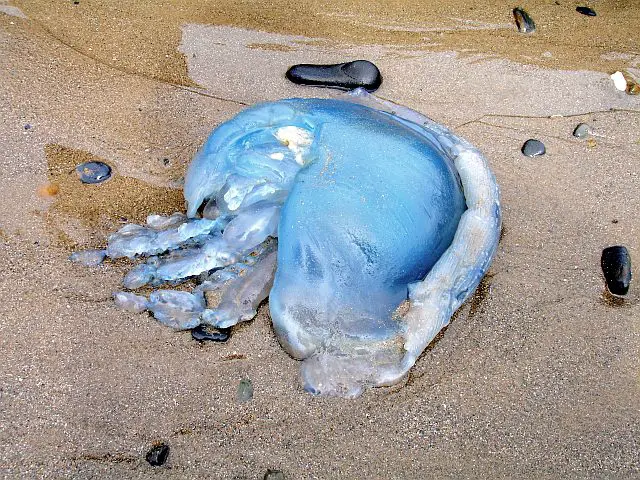Yes, dead jellyfish can still sting you, even if you find one washed up on the beach. And it doesn’t have to be a whole jellyfish – even small bits and pieces of tentacle can cause a painful sting. This is because the stinging cells, or nematocysts, can remain viable and ready to fire for several hours if they don’t dry out completely. The actual stingers are like tiny harpoons that shoot from inside pressurized cells upon contact. This means they can operate even when the animal itself is considered dead.
Jellyfish consist mainly of water – about 95% – and they have no brains, no bones, no heart, and no teeth. You wouldn’t think they have much going for them. And yet they include some of the most successful predators in the oceans.
How Do Nematocysts Work?
The nematocyst is a remarkable specialized stinging capsule with a tiny harpoon coiled inside that can fire in about 700ns (Nütcher et al., 2006), making this the fastest known movement in the animal kingdom.
The harpoon can pierce tissue and inject strong toxins that can kill or immobilize the recipient, depending on the size of the animal. The tip of the harpoon is ejected with great velocity (around 18.6 m/s), hitting the prey with a pressure comparable to that of a bullet (Özbek et al., 2009). Within less than 3 ms the tubule shoots out and injects toxins into the prey.
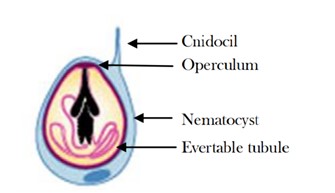
A small hair-like structure (cnidocil) projects from one side of each nematocyst and acts as a trigger. When an animal touches the hair, the nematocyst fires. The main driving force behind the discharge includes a sudden increase in osmotic pressure within the capsule in conjunction with a release of energy by the elastically stretched capsule wall. The sudden increase in pressure turns the harpoon structure “inside out” and each nematocyst fires only once.
Nematocyst structure. Adapted from Ozbek et al., 2009.
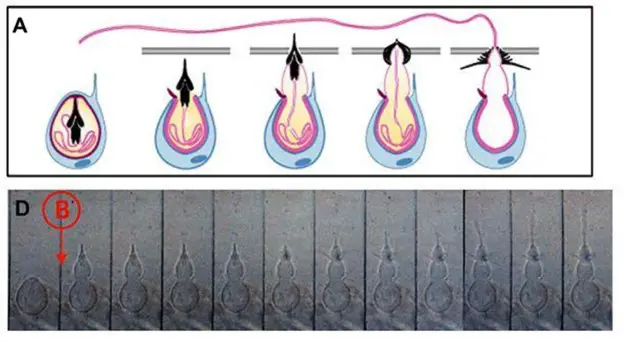
(A) Discharge of a nematocyst in Hydra, depicting the steps in firing, adapted from Nütcher et al., 2006.
(D) photos recorded with a rotary prism camera at 40,000 frames per second, from Holstein and Tardent, 1984.

Nematocyst structure and mechanism, from Montgomery et al, 2016.
The diagram above shows the anatomy of a nematocyst cell and its “firing” sequence, from left to right. On the far left is a nematocyst inside its cellular capsule. The cell’s thread is coiled under pressure and wrapped around a stinging barb. When an animal makes contact with the cnidocil trigger, a flap of tissue covering the capsule called the operculum flies open. The middle image shows the open operculum, the rapidly uncoiling thread and the emerging barb. On the far right is the fully extended cell turned “inside out.” The barbs at the end of the harpoon stick into the victim and inject a poisonous liquid.
Video showing nematocysts firing in slow motion
How Dangerous is Jellyfish Venom to Humans?
While many jellyfish stings can cause pain, only a very few can cause death. The deadliest species have particularly strong venom because they are adapted to killing and feeding on fish.
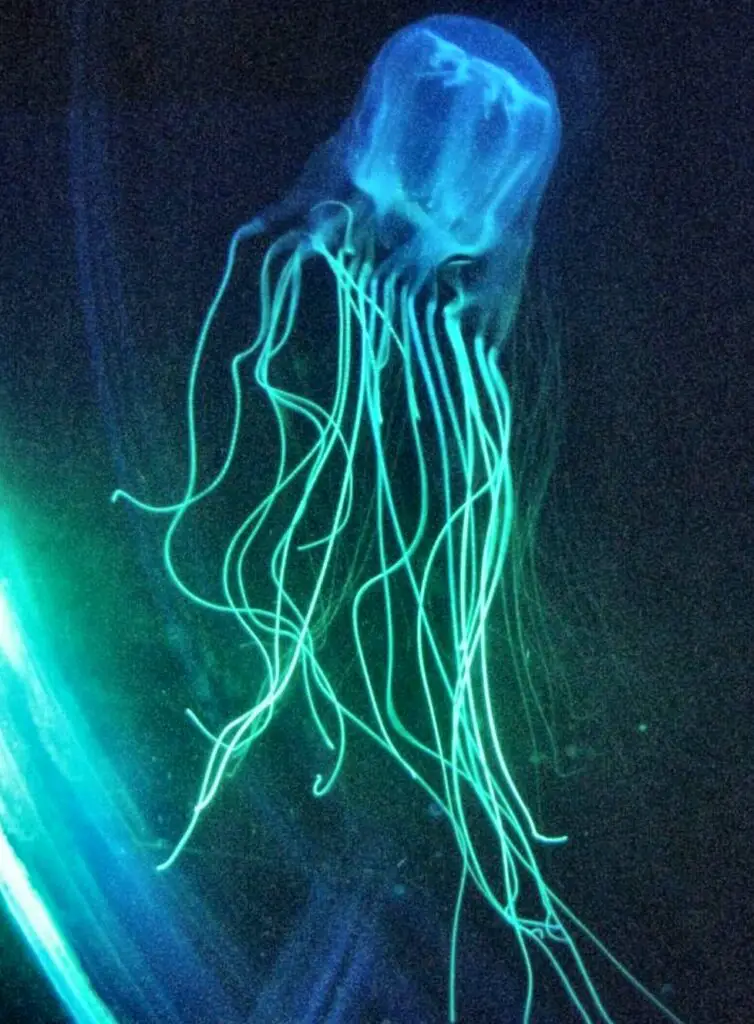
The deadliest stinging cells are found on the box jellyfish, particularly the sea wasp, Chironex fleckeri. C. fleckeri is the most venomous marine animal on the planet, according to the Australian Institute of Marine Science. The stingers can cause excruciating pain to humans, and venom that weighs about as much as a single grain of salt can kill an adult human. A three-to-five-foot length of C. fleckeri tentacle wrapped around a person’s arm or leg is considered sufficient to cause cardiac arrest and death.
A box jellyfish can kill an adult human in 2-3 minutes with only 5-6 feet (2m) of tentacle.
Around 63 human fatalities have been attributed to C. fleckeri over a period of 80 years in Australia—and there are likely many more that were thought to be victims of cardiac arrest.
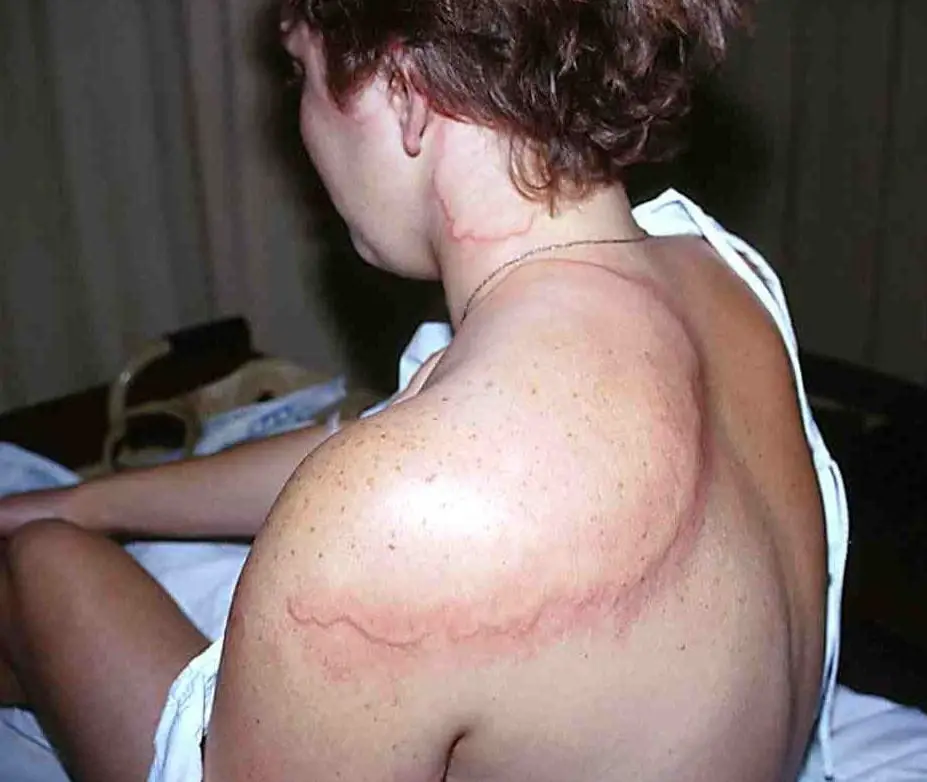
Another potentially deadly jellyfish is the tiny but deadly Irukandji, about the size of a sugar cube and particularly dangerous to swimmers because they are almost transparent in water. The venom of the Irukandji is considered to be one of the most powerful toxins in the natural world.
Do you plan to swim or snorkel in tropical or subtropical ocean waters?
We strongly recommend wearing full-body lycra suits with hoods for the best protection against jellyfish stings. In Australia these are called stinger suits and they provide proven protection against stings.
See my article “Irukandji Jellyfish Facts and Adaptations” to learn more about this fascinating creature and how it uses its deadly tentacles to jig for fish.
One of the most painful jellyfish stings includes that of the relatively common Portuguese Man O’ War (Physalia physalis), also known as the Bluebottle. Another box jellyfish, Chiropsalmus quadrigatus, also has a very painful and potentially deadly sting.
What’s the best first aid for Jellyfish Stings?
Surf Life Saving Australia has approved the use of vinegar (acetic acid) as a best practice in the treatment of potentially fatal jellyfish envenomation (stings) including irukandji and box jellyfish.
Why is vinegar effective for Jellyfish stings?
Vinegar (acetic acid) works on jellyfish stings by neutralizing the nematocysts that have not fired. Jellyfish stings typically involve a length of tentacle remaining stuck to the skin of the victim. Even though a large number of nematocysts fire on contact, there will always be a large percentage of nematocysts that do not make contact and therefore do not fire. However these stinging cells remain viable and potentially dangerous because they can continue to sting even if the piece of tentacle becomes detached from the jellyfish. Vinegar solves this problem by neutralizing the nematocysts and rendering them incapable of firing.
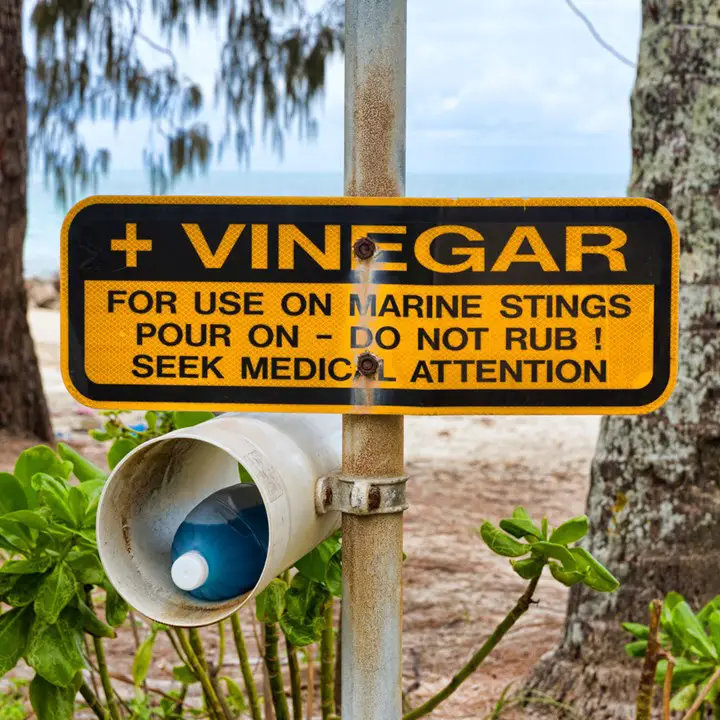
Caution: Do not use ammonia, urine, rubbing alcohol, or fresh water. These can all trigger the release of more venom. If you don’t have vinegar, it is best to try scraping off the stingers with a sharp edge like a credit card. After removing the pieces of tentacle, you can safely apply a cold pack or ice in a bag for analgesia (pain relief).
First Aid for jellyfish stings
Surf Life Saving recommends the following steps In the event of jellyfish stings, including box jellyfish and irukandji:
- If the individual has more than one localized sting or looks/feels unwell, call Emergency for an ambulance
- Provide emergency care including CPR if needed
- Treat the sting by pouring vinegar onto the affected area
- Seek medical aid and transport the patient to hospital
Please note: The information on this site is provided as an information resource only, and is not to be used or relied on for any diagnostic or treatment purposes.
Jellyfish are remarkably successful predators
Jellyfish are not just aimless drifters; they are in fact among the most successful predators ever to swim in the oceans, both today and in the far distant past.
Jellyfish have been incredibly successful on planet Earth for over 600 million years (MY). To put that into perspective, trees have been around for roughly 400 MY, mammals for 200 MY, and the dinosaurs went extinct 65 MY ago. Jellyfish have been around for a lot longer than any of them and have outlived millions of other organisms that have gone extinct during that time.
Some More Secrets to Success of Jellyfish
Another key to jellyfish success is their ability to survive and thrive without having a brain! Even though they don’t have a centralized brain, they do have a complex and effective nervous system consisting of neural nets:
- a “Large Net” of neurons that signal the muscles to rhythmically contract, allowing the animals to gather food and swim.
- A “Small Net” of neurons that help coordinate more specialized behaviors and activities, such as hunting and feeding.
To learn more about these fascinating brainless creatures, see my article “Do Jellyfish have Brains? How Jellies Hunt and Kill without Brains!”

Featured image at the top of this article shows a Blue jellyfish (Cyanea_lamarckii) copyright Penny Mayes, CC BY-SA 2.0 via Wikimedia Commons
References
David, Charles & Özbek, Suat & Adamczyk, Patrizia & Meier, Sebastian & Pauly, Barbara & Chapman, Jarrod & Hwang, Jung Shan & Gojobori, Takashi & Holstein, Thomas. (2008). Evolution of complex structures: Minicollagens shape the cnidarian nematocyst. Trends in genetics: TIG. 24. 431-8. 10.1016/j.tig.2008.07.001.
Holstein, T. and Tardent, P. (1984) An Ultrahigh-Speed Analysis of Exocytosis: Nematocyst Discharge. Science • 24 Feb 1984 • Vol 223, Issue 4638 • pp. 830-833 • DOI: 10.1126/science.6695186
Montgomery, L., Seys, J., Mees, J., 2016. To Pee, or Not to Pee: A Review on Envenomation and Treatment in European Jellyfish Species. Mar. Drugs 2016, 14(7), 127; https://doi.org/10.3390/md14070127
Nütcher, T., Benoit, M., Engel U., Özbek, S., and Holstein, T.W. (2006). Nanosecond scale kinetics of nematocyst discharge. Curr. Biol. 16, R316-R318.
Özbek, S., Balasubramanian, P.G. and Holstein, T.W. (2009). Cnidocyst structure and the biomechanics of discharge. Toxicon 54, 1038-1045.

